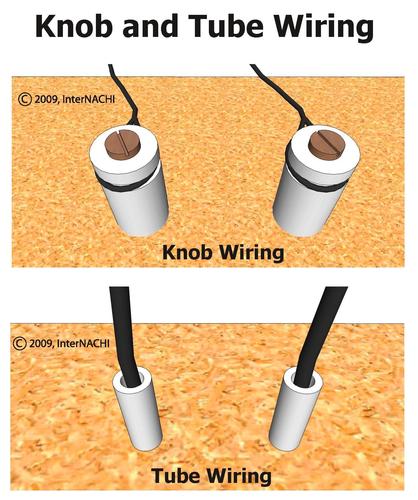Knob-and-Tube Wiring
InterNACHI inspectors should always disclaim knob-and-tube wiring during their inspections.
Facts About Knob-and-Tube Wiring:
- It is not inherently dangerous. The dangers from this system arise from its age, improper modifications, and situations where building insulation envelops the wires.
- It has no ground wire and thus cannot service any three-pronged appliances.
- While it is considered obsolete, there is no code that requires its complete removal.
- It is treated differently in different jurisdictions. In some areas, it must be removed at all accessible locations, while others don't, but inspect it for safety reasons.
- It is not permitted in any new construction.
How Knob-and-Tube Wiring Works:
K&T wiring consists of insulated copper conductors passing through lumber framing drill-holes via protective porcelain insulating tubes. They are supported along their length by nailed-down porcelain knobs. Where wires enter a wiring device, such as a lamp or switch, or were pulled into a wall, they are protected by flexible cloth or rubber insulation called "loom."
Advantages of Knob-and-Tube Wiring:
- K&T wiring has a higher ampacity than wiring systems of the same gauge. The reason for this is that the hot and neutral wires are separated from one another, usually by 4 to 6 inches, which allows the wires to readily dissipate heat into free air.
- K&T wires are less likely than Romex cables to be punctured by nails because K&T wires are held away from the framing.
- The porcelain components have an almost unlimited lifespan.
- The original installation of knob-and-tube wiring is often superior to that of modern Romex wiring. K&T wiring installation requires more skill to install than Romex and, for this reason, unskilled people rarely ever installed it.
Problems Associated with K&T Wiring:
- Unsafe modifications are far more common with K&T wiring than they are with Romex and other modern wiring systems. Part of the reason for this is that K&T is so old that more opportunity has existed for improper modifications.
- The insulation that envelopes the wiring is a fire hazard.
- It tends to stretch and sag over time.
- It lacks a grounding conductor. Grounding conductors reduce the chance of electrical fire and damage to sensitive equipment.
- In older systems, wiring is insulated with varnish and fiber materials that are susceptible to deterioration.
Compared with modern wiring insulation, K&T wiring is less resistant to damage. K&T wiring insulated with cambric and asbestos is not rated for moisture exposure. Older systems contained insulation with additives that may oxidize copper wire. Bending the wires may cause insulation to crack and peel away.
K&T wiring is often spliced with modern wiring incorrectly by amateurs. This is perhaps due to the ease by which K&T wiring is accessed.
Building Insulation:
K&T wiring is designed to dissipate heat into free air, and insulation will disturb this process. Insulation around K&T wires will cause heat to build up, and this creates a fire hazard. The 2008 National Electrical Code (NEC) requires that this wiring system not be covered by insulation. Specifically, it states that this wiring system should not be in…
hollow spaces of walls, ceilings and attics where such spaces are insulated by loose, rolled or foamed-in-place insulating material that envelops the conductors.
Local jurisdictions may or may not adopt the NEC’s requirement. The California Electrical Code, for instance, allows insulation to be in contact with knob-and-tube wiring, provided that certain conditions are met, such as, but not limited to, the following:
- A licensed electrical contractor must certify that the system is safe.
- The certification must be filed with the local building department.
- Accessible areas where insulation covers the wiring must be posted with a warning sign. In some areas, this sign must be in Spanish and English.
- The insulation must be non-combustible and non-conductive.
- Normal requirements for insulation must be met.
Modifications:
- Many homeowners adapted to the inadequate amperage of K&T wiring by installing fuses with resistances that were too high for the wiring. The result of this modification is that the fuses would not blow as often and the wiring would suffer heat damage due to excessive amperage loads.
- It is not uncommon for inspectors to find connections wrapped with masking tape or Scotch tape instead of electrical tape.
K&T Wiring and Insurance:
Many insurance companies refuse to insure houses that have knob-and-tube wiring due to the risk of fire. Exceptions are sometimes made for houses where an electrical contractor has deemed the system to be safe.
Advice for those with K&T wiring:
- Have the system evaluated by a qualified electrician. Only an expert can confirm that the system was installed and modified correctly.
- Do not run an excessive amount of appliances in the home, as this can cause a fire.
- Where the wiring is brittle or cracked, it should be replaced. Proper maintenance is crucial.
- K&T wiring should not be used in kitchens, bathrooms, laundry rooms or outdoors. Wiring must be grounded in order to be used safely in these locations.
- Rewiring a house can take weeks and cost thousands of dollars, but unsafe wiring can cause fires, complicate estate transactions, and make insurers skittish.
- Homeowners should carefully consider their options before deciding whether to rewire their house.
- The homeowner or an electrician should carefully remove any insulation that is found surrounding K&T wires.
- Prospective home buyers should get an estimate of the cost of replacing K&T wiring. They can use this amount to negotiate a cheaper price for the house.

